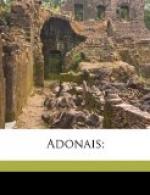1. 2. Their garlands sere, their magic mantles rent. The garlands or chaplets of the mountain shepherds have become sere because (it may be presumed) the wearers, in their grief for the mortal illness and death of Adonais, have for some little while left them unrenewed. Or possibly the garlands withered at the moment when Spring ’threw down her kindling buds’ (stanza 16), I do not well understand the expression ’magic mantles.’ There seems to be no reason why the mantles of the shepherds, considered as shepherds, should be magic. Even when we contemplate the shepherds as poets, we may fail to discern why any magical property should be assigned to their mantles. By the use of the epithet ‘magic’ Shelley must have intended to bridge over the gap between the nominal shepherds and the real poets, viewed as inspired singers: for this purpose he has adopted a bold verbal expedient, but not I think an efficient one. It may be noticed that the ‘uncouth swain’ who is represented in Lycidas as singing the dirge (in other words, Milton himself) is spoken of as having a mantle—it is a ‘mantle blue’ (see the penultimate line of that poem).
1. 3. The Pilgrim of Eternity. This is Lord Byron. As inventor of the personage Childe Harold, the hero and so-called ‘Pilgrim’ of the poem Childe Harold’s Pilgrimage, and as being himself to a great extent identical with his hero, Byron was frequently termed ‘the Pilgrim.’ Shelley adopts this designation, which he magnifies into ’the Pilgrim of Eternity,’ He admired Byron most enthusiastically as a poet, and was generally on easy—sometimes on cordial—terms with him as a man. He has left us a fine and discriminating portrait of Byron in the ’Count Maddalo’ of his poem Julian and Maddalo, written in 1818. At times however Shelley felt and expressed great indignation against Byron, especially in reference to the ungenerous and cruel conduct of the latter towards Miss Clairmont. See some brief reference to this matter at p. 9.
11. 3-5. Whose fame Over his living head like heaven is bent, An early but enduring monument. These phrases are not very definite. When fame is spoken of as being bent over Byron’s head, we must conceive of fame as taking a form cognizable by the senses. I think Shelley means to assimilate it to the rainbow; saying substantially—Fame is like an arc bent over Byron’s head, as the arc of the rainbow is bent over the expanse of heaven. The ensuing term ‘monument’ applies rather to fame in the abstract than to any image of fame as an arc.
11. 6, 7. Came, veiling all the lightnings of his song In sorrow. No doubt it would have been satisfactory to Shelley if he could have found that Byron entertained or expressed any serious concern at Keats’s premature death, and at the hard measure which had been meted out to him by critics. Byron did in fact admire Hyperion; writing (in November 1821, not long after the publication of Adonais)—’His




